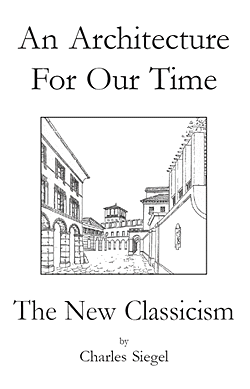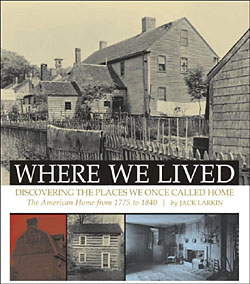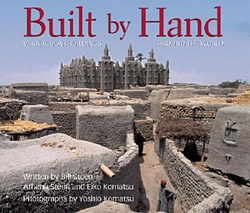
|
||
|
Issue 49 |
|
11 February 2008 |
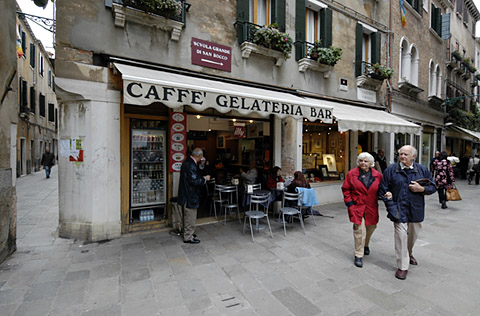 Salizzada San Rocco, Venice ©2005 J.Crawford Announcements
Carfree Design ManualThe text is done except for minor editing of one Part. The illustration count is pushing one thousand. It's now in the hands of the publisher.Carfree Cities AvailabilityBoth the paperback and hardcover editions of Carfree Cities are widely available.Support for Carfree.comEd Beale paid for October, November & December 2007. Dr. Irving Rudman paid for January 2008. Carfree Friends (Netherlands) paid for February and March. Thanks to all our contributors for their generosity.
Carfree.com supports World Carfree Network (WCN) by posting the most important network announcements here. Visit the
WCN web site for full information regarding the Network's activities.
|
|
 Venice ©2005 J.Crawford The Smaller Squares of VeniceThis issue carries some photographs of the smaller squares in Venice. This series will continue in the next issue or two. These squares, some of which are small indeed, are important to the city out of proportion to their size. They provide relief from the narrow streets and give residents local spaces to stop for a chat.Piazza San Marco will eventually be treated, but I will need to return to Venice for still more photographs of the enigmatic but wonderful square.
News Bits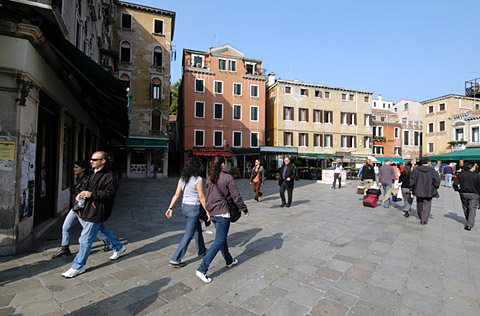 Venice ©2005 J.Crawford 2008 Student Bicycle Essay Contest
A new Student Bicycle Essay Contest has been announced. All under-17 students worldwide are eligible to enter the "Bicycle Essay Contest." The deadline is 1 May 2008. More information
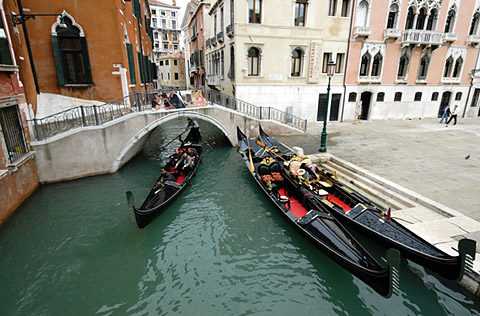 Venice ©2005 J.Crawford Carfree in the NewsGoogle News offers a personalized clipping service, and for quite a while now I have had a section that searches for "carfree." It is interesting to notice that the number of news stories containing this term is increasing fairly steadily. For example, on a recent day, the following articles were available:
"Google News"
Click on "Personalize this page" (upper right)  Venice ©2005 J.Crawford Carfree Station Area, Preston, UKA bus terminal at the Preston rail station forms a key part of a carfree vision for the city center. Mini-buses would shuttle shoppers around once they arrive in the city by train. The station is a five-minute walk from the university, the main shopping center, and the proposed Central Business District. (Do they really need those buses?)Malcolm McVicar, chairman of the Preston Vision Board, said: The future of Preston is clearly not a car-based one. You look at the City of London, which is one of the world's biggest financial centres, and there is absolutely nowhere to park. You look at central Manchester and you dare not take your car there.The only radical thing about all of this is that it's a return to the way things were 60 years ago. Hugh Evans, of the Preston-based North and Western Lancashire Chamber of Commerce, said, "If we want more people to use public transport we must give them a better service." This is not a profound revelation and also pretty much the way things were just 40 years ago in the UK.
"Leader's vision of a car-free Preston" 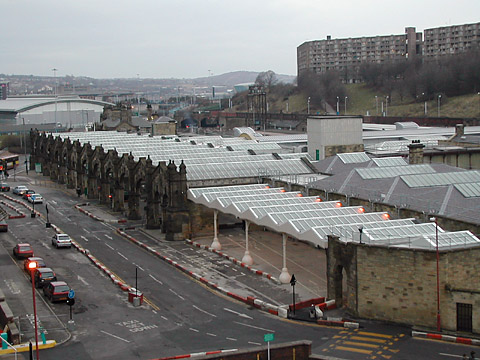 Sheffield before ©2003 Kay Milner Sheffield, UK, City-Center RegenerationSheffield City Center has recently undergone a dramatic transformation as part of the £130 million Heart of the City project. Areas of the city have been rebranded as "Quarters" and Sheffield has changed almost beyond recognition. The plan encompassed seven projects that aimed to improve the area's employment rate, transport system, knowledge economy, and cultural and retail sectors. The public phase includes five open air public spaces - the Peace Gardens, Millennium Square, St Paul's Place, Hallam Square and Town Hall Square - and the Millennium Galleries and Winter Garden.
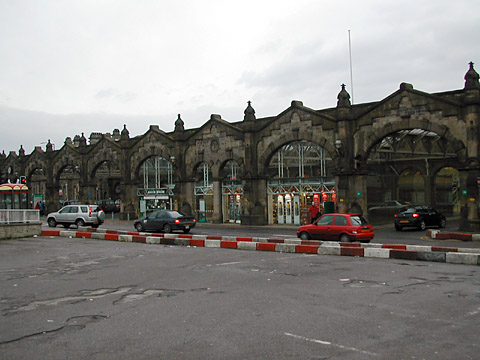 Sheffield before ©2003 Kay Milner The transformation of Sheffield City Station (a hub for both trains and trams) alone cost £50 million and has transformed the station concourse and surrounding area into a gateway for visitors arriving in the city, as can be seen in the photographs below. The taxi and drop-off point (previously located directly in front of the historic station façade) has been relocated, the main road passing the station has been repositioned and replaced with a stunning civic plaza, complete with benches, fountains and shady trees. A "wall of water" shields the plaza from traffic and leads pedestrians across the space to a newly-designed pedestrian crossing, from which they can access the city center.
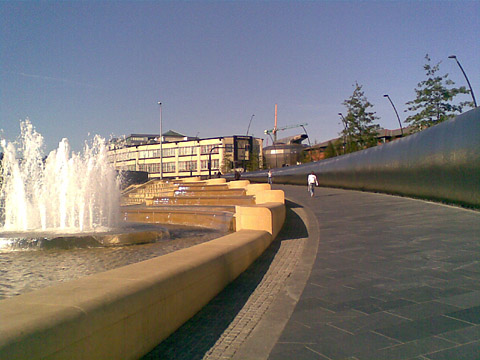 Sheffield after The plaza forms part of a network of public spaces throughout the city, designed to improve the environment for walking and cycling and provide a "mental map" for those moving about the city. The city center's "Gold Route," which takes in the railway station, won the Best-Designed Regeneration Development award. One of the judges, Alexandra Rook, commented "The effect on the visitor's experience has been dramatic. There has been an increased footfall and it has created a place where people want to linger."
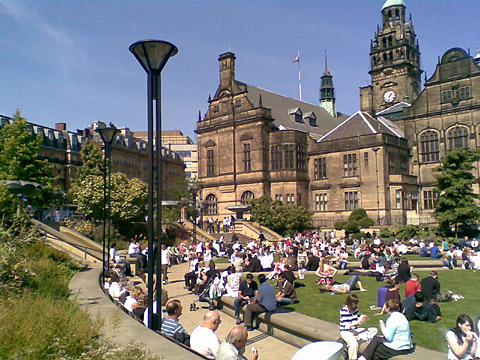 Sheffield after
Special to Carfree Times 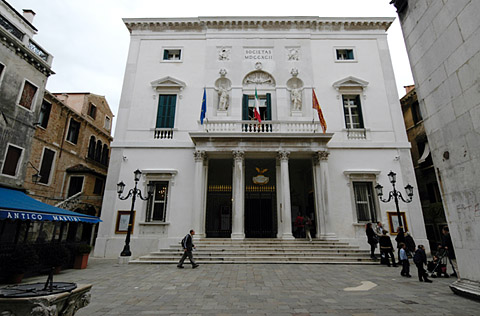 Venice ©2005 J.Crawford Day of the Arts: Times Square UnpluggedSilke Schilling, a long-time friend of WCN, is working to organize an event that would transform the very heart of Manhattan. The rest of this article is from her.Come with me and envisage the following scenery: The flashing lights on Times Square's high-rises have been switched off, the motorized vehicles have disappeared - Times Square unplugged. People are sitting on benches or rugs and on the pavement, watching the pigeons, the passers-by, the street ballet, talking, thinking, contemplating, and enjoying the sun and the scenery just like on an Italian piazza - Times Square is La Piazza del Tempo. The artists of New York are holding a gathering. In fact, everybody is an artist in one way or the other. You are one as well. Imagine all these hundreds of painters behind their easels; see the women, men, and children drawing, sculpting, making pottery, writing poetry and stories; see yourself creating - in the Square of the Arts. The dancers from the theaters, their audiences, the staff of all the hotels, the residents, the bankers, the shoppers and the tourists have come out in the open. There is music, folk, tango, hip-hop and opera - the entertainment and the music of the world. People dance and we join in with our own drums. For once, let us do the play ourselves - a day and a night on Broadway. Quiet Squares of the World
You don't live in New York? HowLet us find the tune of Times Square and find our own - with our own eyes and ears, with our own hands and feet and voices, until we are happy, exhausted, and blissfully ecstatic. And let us be quiet so the place can speak: through our works of art created during those 24 hours: the music, the images, the poetry, the dance of the people of New York City. All of these people, all of us, we are here, we are now, we are in the moment, we are aware and we see - the mystery of Times Square. It is a vision which can become reality.This vision - an unplugged Times Square, La Piazza del Tempo, the Square of the Arts, a self made play on Broadway, the unraveling of the mystery of Times Square can become reality if you want it. The Day of the Arts will happen if everybody wishes it and is interested in it: the people of New York City, the Times Square Alliance, every single business, office, and resident in the area, and the City of New York. It takes our combined action and it has to become a win-win situation for everybody involved, for all of us. Spread the word. Forward the message to everybody on your mailing list. Talk about this project with your friends, your colleagues, your family, the people in the streets; discuss the idea. Come up with your own ideas. Talk with us, e-mail us, tell us what you want. Ask questions. Tell us about your ideas. We will write what you have written to us. We will put it in our diary. Please write to your officials, write to your mayor, to your Arts Department, to The Times Square Alliance, to anybody who you believe could help to make it happen. If you are an organization, part of the administration, a Times Square based business please get in touch. Would you like to support us in any way? We would appreciate any help you can offer. When the time comes that it manifests, please do not hesitate, take what you need for a day and come to Times Square. Bring your friends and your family. Bring your ideas, your art, your tools, your peace and your joy. Bring your love to our public places. You are welcome. The April session is meant to be a rehearsal on a very small basis, the morning with about 30 people maximum. I cannot estimate how many people might turn up without telling me in advance, hence I need people to sign up so as to know and limit how many we will be, because I cannot afford trouble with police and permissions. Artists' morning meditation - April 2008What do we see on Times Square? What do we see underneath? What is it? What does it mean? What does it express? Come with me to Times Square and enter into its strata!This four hours meditation and arts session is meant to get our small group of about thirty people maximum a taste of how it could be with about thirty thousand. We will find our quiet spots in the noisy corners of Times Square. It can be a rehearsal. It will be opened by a led meditation that can help you enter the deeper layers of this exciting place. You can decide how you would like to stay in tune with Times Square throughout the following hours. Draw or paint what you see and what you feel, put it into poetry, or show us all the angles of this amazing place that you want through the lens of your camera. Write a song if you feel inspired. If you would rather like to give some peace and quiet to the place and to yourself, please feel free to do so. Participation is free. However, if you would like to support the initiation of the Day of the Arts, you might like to donate an image of the work that emerges from this gathering. We would like to exhibit your visions on this website if you agree. With your visions and your work you can help us raise interest and funding to make the Times Square Day of the Arts actually happen. As we can accept only a limited number of participants for this meditation, please get in touch to learn about the time and place to meet. Please sign up beforehand by emailing us at mail@dayofthearts.com This is a beautiful vision. I wish Silke every success. Stay tuned. 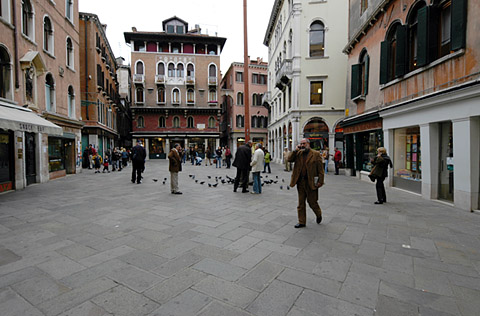 Venice ©2005 J.Crawford "Very Important Pedestrian Day" a Commercial SuccessLondon's Mayor Ken Livingstone declared Saturday, December 2 "Very Important Pedestrian Day" and completely closed three of the city's main shopping strips to automobile traffic. Street entertainers took over and the day finished off with a massive fireworks display. People on these crowded streets finally had room to move . . . and shop. A million people descended on the carfree streets and proceeded to engage in a £100 million spending spree.Livingstone, who opened the event, said: It has become a major event in London's calendar in the run-up to Christmas [and] shows us all what the West End will be like in 2013 with traffic removed and the streets turned over to the pedestrian.Everything apparently went very smoothly, even though the streets were absolutely jammed, with pedestrians. Steve Hammer of Columbia's Urban Energy Program remarked, "I suppose the lesson from all this is that the way to decrease conspicuous consumption is to route the heaviest traffic through our shopping areas." Could work, don't try it.
"This Holiday Season London's Streets Are 'Absolutely Jammed'"
 Venice ©2005 J.Crawford Civility"Our shared spaces have become a bear pit," according to the Guardian:A grey weekday morning at 7.40am in Edmonton bus station in north London, and it's teeming with schoolchildren. As the bus arrives, a crowd surge forward to squeeze their way on. People get knocked over. The children, screaming and pushing, panic. Small ones, horrified by the melee, hold back. The ones with the sharpest elbows make it. The rest have to go through the ordeal again with the next bus and the next - and get bad marks for being late when, battle-scarred, they finally make it into school.The writer, Madeleine Bunting, was enraged by the scene, which has apparently become routine in Britain. This nation, once renown for the courteous manner in which its citizens queued for buses, now allows melees like this as a matter of routine. How does this happen in a supposedly civilized nation? She then asks: How can we complain about children's antisocial behaviour when we show such dereliction in developing in them any understanding of social behaviour? Where are the buses, the stewards or bus conductors they need? Why are transport services in poorer areas so under-resourced? Treat people like animals and, chances are, they will end up behaving like them. Every morning, these kids are getting a crash-course in how aggressive self-assertion is your passport in life.One-third of respondents told the British Crime Survey that they were worried about antisocial behaviour. People are worried about deteriorating interactions between strangers, seen as a pathology of individual entitlement. Antisocial teenagers are only replaying the aggression and indifference that has been meted out to them. There is at least a simple way to reduce the pressure: run enough buses.
"From Buses to Blogs, a Pathological Individualism Is Poisoning Public Life: 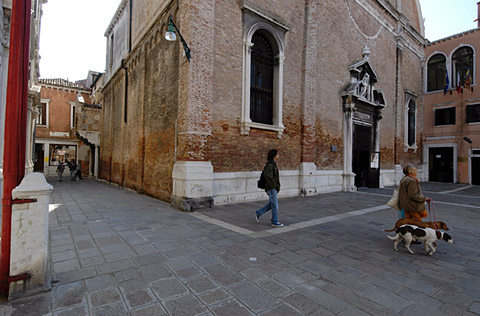 Venice ©2005 J.Crawford Biofuels & FoodThe Guardian begins:It doesn't get madder than this. Swaziland is in the grip of a famine and receiving emergency food aid. Forty per cent of its people are facing acute food shortages. So what has the government decided to export? Biofuel made from one of its staple crops, cassava. The government has allocated several thousand hectares of farmland to ethanol production in the county of Lavumisa, which happens to be the place worst hit by drought. Jean Ziegler, the UN's special rapporteur, described this as "a crime against humanity." Rich drivers will snatch food from poor people's mouths. Even the International Monetary Fund warns that using food to produce biofuels "might further strain already tight supplies of arable land and water all over the world, thereby pushing food prices up even further." The UN Food and Agriculture Organisation warns of the lowest global food reserves in 25 years. Even when food prices were low, 850 million poor people went hungry. The warnings are falling on the deaf ears of major governments. Biofuels create the illusion that carbon emissions can be cut while transport networks continue to expand. No hard truths have to be faced. Oh, and a recent study by Nobel laureate Paul Crutzen reveals that nitrogen fertilizers generate nitrous oxide, a greenhouse gas 296 times as powerful as CO2. A paper in Science recently claimed that protecting uncultivated land saves, over 30 years, between two and nine times the avoided carbon emissions from ploughing and planting biofuels. The Guardian concludes: If the governments promoting biofuels do not reverse their policies, the humanitarian impact will be greater than that of the Iraq war. Millions will be displaced, hundreds of millions more could go hungry. This crime against humanity is a complex one, but that neither lessens nor excuses it. . . . Like all such crimes it is perpetrated by cowards, attacking the weak to avoid confronting the strong.
"An Agricultural Crime Against Humanity:  Venice ©2005 J.Crawford Endless Growth Questioned, FinallyGeorge Monbiot began a recent article in the Guardian by saying:When you warn people about the dangers of climate change, they call you a saint. When you explain what needs to be done to stop it, they call you a communist. Let me show you why.Yet the UK's plan is not even approaching reality. The 60% cuts in CO2 emissions that were to happen between 1995 and 2050 are nowhere close to reality, and the newest proposals call for an 80% cut. The latest summary from the Intergovernmental Panel on Climate Change (IPCC) links various cuts to likely temperatures. To prevent global warming from exceeding 2C, the world will need to cut emissions to roughly 15% of the year 2000 volume by 2050. Monbiot worked out the math: I looked up the global figures for carbon dioxide production in 2000 and divided it by the current population. This gives a baseline figure of 3.58 tonnes of CO2 per person. An 85% cut means that (if the population remains constant) the global output per head should be reduced to 0.537 tonnes by 2050. The UK currently produces 9.6 tonnes per head and the US 23.6 tonnes. Reducing these figures to 0.537 means a 94.4% cut in the UK and a 97.7% cut in the US. But the world population will rise in the same period. If we assume a population of 9 billion, the cuts rise to 95.9% in the UK and 98.3% in the US.We're not going to get even close to these numbers by all driving Priuses. And various positive feedback mechanisms may worsen the outlook further. Apparently, to hold the ultimate rise to no more than 1.5C above pre-industrial climate requires a 100% cut. No more fossil fuels. The Kyoto protocol failed. Since its signing, global emissions have actually accelerated. The current production of CO2 exceeds even the IPCC's worst-case scenario. Anthropogenic CO2 output is now growing faster than at any time in history. Monbiot concludes, "In the UK there is a stupefying gulf between the government's climate policy and the facts it is creating on the ground." Worse yet, ". . . if our economy grows at 3% between now and 2040, we will consume in that period economic resources equivalent to all those we have consumed since humans first stood on two legs." Monbiot thinks there is still hope. Referring to the dark days of WW II, he says: Though the war often seemed impossible to win, when the political will was mobilised strange and implausible things began to happen. The US economy was spun round on a dime in 1942 as civilian manufacturing was switched to military production. The state took on greater powers than it had exercised before. Impossible policies suddenly became achievable.One of these days people will come round to the idea of carfree cities. We'll be there waiting.
"This Crisis Demands a Reappraisal of Who We Are and What Progress Means 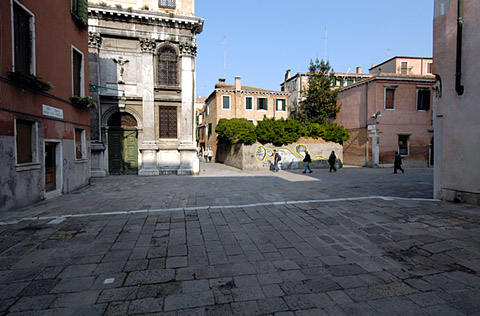 Venice ©2005 J.Crawford What's Wrong With Car-LiteDiana DeRubertis, an environmental journalist and "seasoned pedestrian" took a look at the New Urbanist development in San Diego where she lives and considered its shortcomings. The place is supposedly a "Traditional Neighborhood Development" (TND) but she does not agree. The development, Rio Vista West, is a big luxury apartment/condominium project with attractive architecture, ground-floor retail, and a tram halt. This notwithstanding, few pedestrians are to be found beyond the very center of the district. "Despite the tree-lined sidewalks, this community and its environs are ruled by the automobile."Despite the TND mumbo-jumbo, the priorities are really for cars, not walkers. Rio Vista West is boxed-in by multi-lane collectors that feed traffic to the area's many shopping malls. There's big box store in the middle of the usual big box parking lot. The area is scaled for cars, not people. Pedestrians who attempt to venture into nearby areas face daunting intersections, heavy traffic, and parking lots. Rio Vista is not really walkable beyond its own driveways. Then there's the need to get on the freeway to reach the nearest grocery store. Peter Calthorpe's original plan appears to have been for a real Transit-Oriented Development (TOD). There was a network of paths and plazas, a community center, a grocery store, and green space. The developers abandoned that plan in favor of yet another shopping mall. DeRubertis complains: Auto-centric New Urbanist communities are not uncommon, at least in Southern California. In fact, the challenge for pedestrians lies in the nature of these expansive, master planned projects that are built from scratch on greenfield or infill land. . . . [T]hey are constructed on such a large scale that they end up mirroring conventional subdivisions, particularly in their use of wide collector and arterial roads. . . . Many of the suburban TND's in the San Diego area fail to meet pedestrians' basic needs, such as human-scaled dimensions, narrow streets, diffused traffic, a nearby market, and active building fronts (many buildings are security gated). . . .If we're going to succeed with car-lite projects, it will probably be necessary to make them actually carfree. At least in California.
"Pedestrians Lost In The New Suburbia" 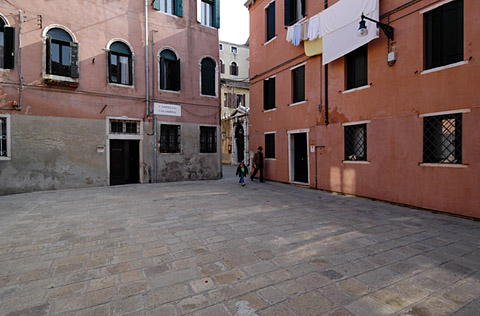 Venice ©2005 J.Crawford Car-Lite Amsterdam?Amsterdam's Labor Party proposed to greatly reduce inner-city traffic in order to improve air quality. Council member Myriam Bergervoet said, "It is not necessary that everyone can reach the inner city by car." Cars should be reserved mainly for residents. Cleaner trucks are needed. Owners of comparatively clean cars should have preference for parking permits. Owners who trade in an old diesel car should get a premium. There must be more park-and-ride facilities and a fine-grained public transport network.In Amsterdam, "fine-grained public transport network" means trams instead of metros, a point of contention in the city for many years. In this relatively small city of moderate density, trams make quite good sense.
"PvdA: auto's uit binnenstad"  Venice ©2005 J.Crawford Suburbs and HealthStudies show that the rate of heart attack increases with the length of time stuck in traffic, according to Kim Connelly, an Australian cardiologist. He would not live in the suburbs himself. A recent study, "Neighbourhood Environments, and Resources for Healthy Living: a Focus on Diabetes in Toronto," points out the link between diabetes and neighborhoods where opportunities for physical activity are limited. Dr, Gillian Booth, co-lead author of the study, says simply, "Your neighbourhood may be making you sick." She notes that half of all Canadians are now overweight, a factor in both diabetes heart disease. She continues: Regularly walking briskly five times a week is a great health benefit. Living in an activity-friendly neighbourhood, one where you can walk to different activities is now shown to be an advantage in avoiding disease. In some of the suburbs, there are no sidewalks, let alone any grocery stores or community centres or schools within walking distance. Often, access to public transportation is limited too.The evidence is mounting. In one U.S. study, researchers found that children who lived within 500 meters of a freeway from the age of 10 had substantial deficits in lung function by the time they were 18. According to the Sierra Club, a significant body of scientific evidence is emerging linking pollution from motor vehicles to asthma, lung cancer, and premature death. Some younger Canadians, especially those who have never owned a car, walk and bike everywhere. They want to live in small urban villages that have shopping. They want to live near their work and without starting to drive. One issue is emerging very clearly: Only people with some money are able to live in urban environments that permit walking. They have become popular enough that poorer people are being priced out. The simple solution, of course, is to create additional pedestrian-friendly, transit-rich neighborhoods.
"Are the suburbs a health hazard?  Venice ©2005 J.Crawford The Netherlands: Tax CO2 EmissionsNo progress is being made in reducing Dutch CO2 emissions. The Dutch, as one of the major players in European distribution, need to take the lead, according to advice to cabinet ministers for economics and transport. The approach is to charge, as soon as possible, for CO2 emissions. Both businesses and individuals need to be charged enough to seek more sustainable alternatives. The charges should be applied to all forms of transport.Ideally, a global system would be implemented. More realistic is a proposal for a European system. Achieving even this might take decades, so the advice has been to charge road traffic for kilometers driven, with the charge per kilometer determined by the rate of CO2 emissions. Aircraft would be charged landing fees in relation to the CO2 emissions of the aircraft. It would have to be implemented at all of the large airports in Europe. Similarly, fuel oil for ships would have to be taxed. The advantages of taxation are held to be that the customer can search for better modes that emit less and would therefore come to be less expensive.
"Advies: Belast CO2-uitstoot vervoer" 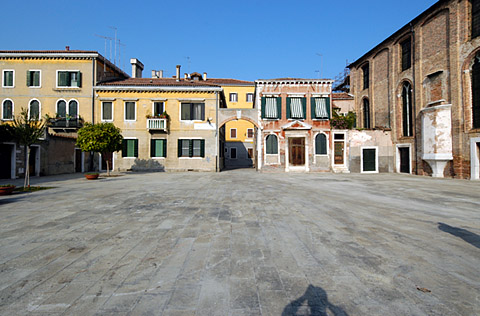 Venice ©2005 J.Crawford London to Tax Dirty TrucksThe most heavily polluting trucks face charges of £200 a day to enter Greater London's Low Emission Zone (LEZ). Cameras will record all large trucks entering the zone to verify that they meet EU norms. Those that don't will have to pay. The rules will soon be extended to buses. Unlike London's congestion charge zone, which is not in effect evenings or weekends, the LEZ is always in force. It covers a much larger area than the congestion zone.About 10% of all trucks are thought not to meet the emission standards. Despite recent improvements, London's air quality is the worst of any city in the UK and one of the worst in Europe. Transport for London, which is implementing the zone, says it will improve life for people with asthma, cardio-vascular disease, and other health conditions. And all the rest of us.
"UK's first emissions zone begins" 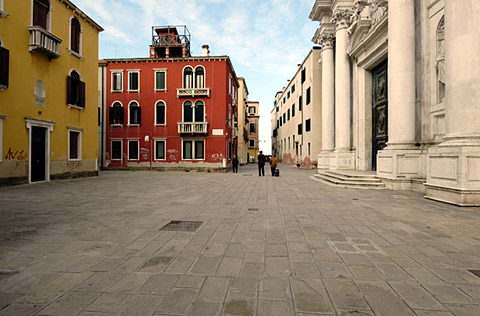 Venice ©2005 J.Crawford Changing Perceptions of Traffic in the UKOur UK correspondent Dave Morris notes that things are changing in the UK. The London Evening Standard, once a rabid opponent of any effort to tame traffic, is now campaigning for tougher pro-cycling laws, improved driver awareness, and so forth.Mayor Livingstone has given London Boroughs the power to implement 20 MPH (about 30 km/hr) urban speed limits as the local default. The current limit is 30 MPH (about 50 km/hr). The Automobile Association is running the usual disinformation campaigns:
1. Ignore the fact that it is not proposed to reduce the speed on main arteries below 30 MPH. No surprises there. Feature ArticleThe New PedestrianismA Practical SolutionBy Michael E. ArthEfforts to create car-free towns remain stymied, despite the charm, beauty, health, safety, and quality-of-life issues that would be greatly enhanced in such enclaves. There is a practical solution to this impasse. New Pedestrianism (NP), a much more idealized form of New Urbanism (NU), offers a way to build pedestrian villages - while still satisfying the demand for automobile and emergency access. For general applications, the key is to create completely separate networks so that the vitality and serenity of a pedestrian network is not comprised by the sight, sound, stench, danger, and aesthetic degradation created by the presence of motor vehicles. There would still be niche applications where the goal of carfree, or nearly carfree villages could be realized, while still satisfying demands for automobile access everywhere else. There are three basic types of pedestrian villages:
The third type, with pedestrian lanes in front and streets for motor vehicles in back, is the version that holds the most promise for being adopted in new towns and neighborhoods:  Left: New Urbanism, Right: New Pedestrianism. © 1999 Michael E. Arth
While New Urbanism puts cars on both sides of the buildings, New Pedestrianism consigns cars to an attractive rear street. Cyclists and pedestrians are on the preferred network in front. Formal street trees are on both sides of the houses, thus insuring an urban forest. Pedestrian lanes connect courtyards, plazas, waterfronts, greenbelts and parks to every single house and business. Pedestrians always have priority at crossings, although pedestrians cross over or under collector and arterial streets, and highways. All attractive natural features (like waterfronts, parks, or greenbelts) are fronted with pedestrian lanes so that they are not degraded by the presence of cars.
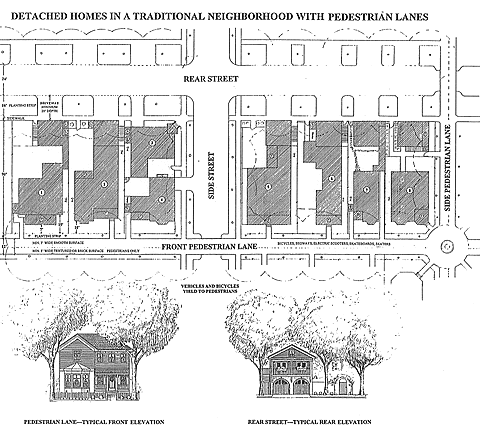 Front pedestrian lanes, rear streets © 1999 Michael E. Arth
Note that the rear street behind a residence still has an attractive carriage house, formal street trees, and a garden wall with a gate for visitors arriving by car. The residential street pinches down when crossing a pedestrian lane, and the pedestrians and cyclists have priority. The pedestrian lane is texture coded. The pedestrian side has a texture (stamping or pavers) and the bicycle / Segway / skating side is smooth. In addition to New Pedestrianism, technological developments could soon have the result of vastly reducing global dependency on the automobile. In the coming decade this will include autonomous robotic cars, and fully-immersive virtual reality. We could trade the world’s 800,000,000 cars for perhaps 1/10th as many driverless taxies and shuttles. After all, more than 90% of the time, cars are just sitting around taking up space, and contributing to the automobile slum that we now live in. Motor vehicles kill 42,000 people a year, and injure or maim another 3 million, in the U.S. alone. That’s equivalent to another 9/11 every four weeks. Since almost all accidents are driver-related, we can virtually eliminate this carnage by switching to driverless cars. When we need a lift, the appropriate vehicle will come to us. For a fraction of the cost and hassle of owning a car, we can still have our transportation needs met. Because of the growing role of virtual reality, transportation beyond our walkable pedestrian villages will become increasingly unnecessary. Thus, we will be able to further reduce the number of cars - perhaps by another 90% or more - by continuing the development of fully-immersive, virtual reality. Most travel will be eliminated when we can finally work and play in a cyber-world that is more effective and fun than the real world. Automobile and motorcycle enthusiasts of the future will get their kicks on an isolated stretch of cyber-route 66. As this trend continues, we will have to have attractive village-like towns that encourage us to walk, cycle, and physically interact both socially - and with the environment - in a way that maintains both the health of the body and an interest in the real world. A third development, which is at least three decades away, will involve the replacement of the current manufacturing and delivery system (requiring delivery trucks and retail outlets) with molecular manufacturing, commonly known as nanotechnology. Desktop devices will some day produce nearly any object - from wholesome, gourmet meals to supercomputers - from nearly anything else. Thus any discarded object could be recycled into any new object. By then we will be living in a world in which reckless drivers will be a thing of the past and our existing, urban crudscape will be recycled into places that will only grow more beautiful over time.
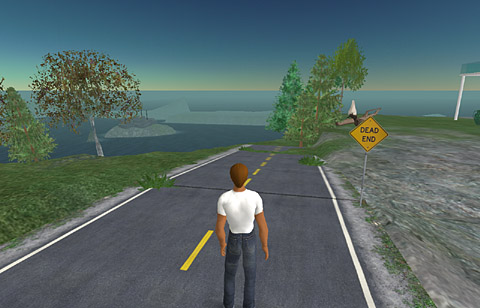 My avatar in Second Life, Freddie Olmstead, cheerfully faces a car-free world with a lonely road grown over with trees and plants. Now he's looking forward to more realistic, fully-immersive, virtual reality. Screen shot © SecondLife.com Michael E. Arth is a home, landscape, and urban designer, as well as an artist, real estate developer, writer, filmmaker, and futurist. Arth founded the more idealistic branch of New Urbanism called "New Pedestrianism" in 1999. Books include Introspective 1972-1982 and three works-in-progress: The Labors of Hercules: Modern Solutions to 12 Herculean Problems, The Past, and The Future. His documentary feature film about New Pedestrianism, and how he rebuilt a slum neighborhood in Florida, New Urban Cowboy: Toward a New Pedestrianism, will soon be available on DVD. Two more documentaries are planned for 2008: The Labors of Hercules and UNICE, which is about the future. (A revised review of New Urban Cowboy will be published on the basis of a re-edited version now in preparation.)
Feature Article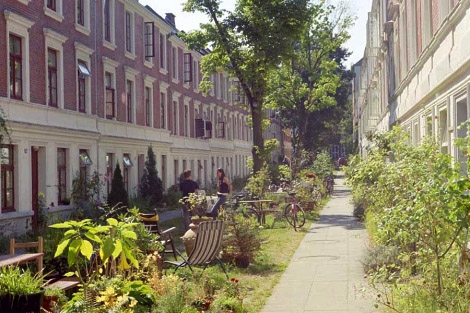 Falkenried, Hamburg © Markus Heller Carfree ConversionsSome Difficult Lessons LearnedBy Markus HellerThe fastest way to create carfree areas is to build them as new developments. So far as I know, there are few examples of existing residential areas converted to carfree. (This is not the same as the introduction of pedestrian streets, because usually only main shopping areas are involved, not residential areas.) There are only two known cases of residential conversions, and these either failed or are not consistent with the Carfree Area Pilot Project approach. (We would be very glad to learn of other examples.)The two principal issues regarding the conversion of existing areas into carfree neighborhoods are:
In the first case, an attempt in Halle, Germany, (the Johannesplatz) largely failed. (This was presented at TCFC IV.) In the end, only 40 meters of street were pedestrianized. (The conversion of the entire neighborhood had been the goal.) A full citizen-participation process was followed, but in the end, a small bloc of elderly residents stopped the conversion. In the second case, the existing Falkenried area in Hamburg (see photograph above) was considered. However, this area had always been carfree, so there was in fact no conversion. The interesting point here is that, according to some residents who were involved in a reconstruction during the 1990s, there was never any discussion of cars. So it seems, that the carfree atmosphere was simply accepted by all. (This may have been because the streets were simply too narrow for any reasonable introduction of cars.) So the question remains: why are there not more examples? The reason is fairly simple. Many existing residents will have built a life that revolves around what can reasonably be considered "essential" driving. (Getting to work would probably be first on the list.) It doesn't matter that many of the existing residents don't have or use cars; the needs of those who do have them and who maintain that their use is essential, will dominate the discussion. Not even all carfree households will want a carfree environment; they fear that their friends and family won't come to visit. A recent attempt at carfree conversion was made in Berlin. It involved a street in Prenzlauer Berg (in the former East Berlin), where a lot of greens live. During the Communist period, they revolted against the government in heroic actions. The district wanted to reconstruct the street, and this led to a long discussion of how the street should look after reconstruction. The process began by finding out how many residents were carfree. If it was a majority, then the idea was that the street should be made carfree in proportion to the number of carfree families living on it (so if 70% of families are carfree, then 70% of the street should become carfree). A public opinion poll was given to all residents. Here are the rather surprising results:
The only encouraging result was that 23.8% were interested in developing a mobility service that rents bicycles, arranges car sharing, and so forth.
This had been a promising neighborhood, one that was open to new ideas and sensitive to environmental issues. To have had such disappointing results is very discouraging. There is no notion that a neighborhood exists in Berlin where a carfree conversion might find a better chance of acceptance.
Markus Heller works as freelance architect in Berlin, Germany. In recent years he has worked as project director of the "Carfree Quarter at the Panke" in Berlin-Mitte. From 1995-2001 he was an independent consultant for the Green Party in the parliamentary council of the district Berlin-Mitte for "City Development, Building and Transportation." Heller was on the Steering Committee of World Carfree Network for three years before being elected to the Advisory Board last year. He also leads both WCN member organizations Autofrei Wohnen and autofrei leben! e.V. (German only).
Books & Films
This short book explores pretentious avant-garde architecture and considers humanist architecture as an alternative. It describes Modern projects where the desire to be new and different at any cost resulted in unlivable buildings, some of which even cause vertigo. These novelties get plenty of press attention. This book considers the work of architects who have worked for decades to create a human-scale, neo-traditional architecture. Architecture reflects larger cultural issues. This is a bad time in history to be ignoring human values and adopting every passing technology. Indeed, the central task of our time is to humanize our technology. That is why the New Classicism is an architecture for our time.
I stumbled over this book and bought it on impulse. I have been writing recently about vernacular styles and how well suited they usually are to the circumstances that give them birth. This book explores how the vast stands of old-growth softwoods in the northern USA were converted into houses over a span of centuries. Today this timber is essentially logged-out, and the once-suitable vernacular that relied upon it is now maladaptive. The book also considers the town houses that were built of brick in US cities, starting a remarkably long time ago. This remains an appropriate vernacular in many parts of the USA. A more sustainable vernacular architecture is needed that reflects the end of cheap, old-growth softwood lumber in the USA. The new architecture must be based on energy conservation, durability, and higher density. Fortunately, one of the many Depression-era work projects was to locate and photograph these old buildings, and the work was done to very high standard by people who were probably desperate for the money. They may themselves not have understood how important their work would become. It is instructive to page through the hundreds of beautiful vernacular buildings in this lovely book. This should also give rise to an urge to preserve them.
I also stumbled over this book and knew at once that I would buy it. It differs from Where We Lived by being global in scope and covering virtually every kind of surviving vernacular architecture. It is beautifully printed in full color on heavy stock (and is a great deal if you buy your books by the pound!). It is organized by building material, type of location, local conditions, specialized buildings, entire communities, and construction details. This is a suitable and useful arrangement. What I find so inspiring about this book is that even though conditions and materials vary over a enormous range, the solutions are nearly all very pleasing to the eye. This reinforces my conviction that solutions that arise in response to real limitations, needs, and opportunities are normally also pleasing to us, because the rightness of their design is immediately evident. In many cases, the local geography is reflected in the buildings, which makes them appear to grow naturally from the site.
Hot New LinksThe links below will open in a new browser window:
The Prophet of Climate Change: James Lovelock by Jeff Goodell. One of the most eminent scientists of our time says that global warming is irreversible - and that more than 6 billion people will perish by the end of the century. Car-Free, Solar City in Gulf Could Set a New Standard for Green Design The End of Sprawl? by Eduardo M. Peñalver The "Thanksgiving miracle" by Neal Peirce Courtyard Living: A Portland-based competition announces winning proposals to promote higher-density housing Ciclovia Bogotá [Flash!] Promoting and creating built or natural environments that encourage and support physical activity from the NHS [PDF!] Smart Transportation Emission Reductions from VTPI [PDF!] Copenhagen: City of Cyclists [PDF!]
About Carfree Times
Next Issue
Subscribe to Carfree Times
Write for Carfree Times
|
| Editor | J.H. Crawford |
| Send e-mail | |
| URL | http://www.carfree.com/
|
![]()
Back to Carfree.com
Carfree Times Home
Back to Carfree Times Issue 48
Forward to Carfree Times Issue 50
About the book: Carfree Cities
E-mail
carfree.com
Copyright ©2008 J.Crawford


